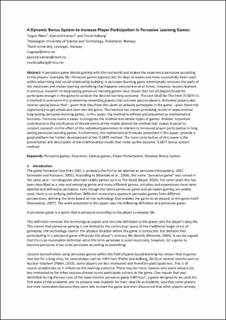| dc.contributor.author | Pløhn, Trygve | |
| dc.contributor.author | Iversen, Kjærand | |
| dc.contributor.author | Aalberg, Trond | |
| dc.date.accessioned | 2021-09-07T11:24:58Z | |
| dc.date.available | 2021-09-07T11:24:58Z | |
| dc.date.created | 2020-11-13T13:36:55Z | |
| dc.date.issued | 2020 | |
| dc.identifier.citation | Proceedings of the ... European conference on games-based learning. 2020, 427-434. | en_US |
| dc.identifier.issn | 2049-0992 | |
| dc.identifier.uri | https://hdl.handle.net/11250/2774002 | |
| dc.description.abstract | A pervasive game blends gaming with the real world and makes the experience pervasive according to the players’ everyday life. Pervasive games typically last for days or weeks and have successfully been used within advertising and social relationship building. A pervasive learning game intentionally removes the walls of the classroom and makes learning something that happens everywhere at all times. However, lessons learned in previous research on long-lasting pervasive learning games have shown that not all players/students participate enough in the game to achieve the desired learning outcome. The-Last-Shall-Be-The-First (TLSBTF) is a method to overcome this problem by rewarding players that activate passive players. Activated players also receive special bonus that – given that they from this point on actively participate in the game – gives them the opportunity to get ahead and even win the game. The method has shown promising results in experimental long-lasting pervasive learning games. In this paper, the method is refined and presented as mathematical formulas. Formulas make it easier to integrate the method into similar types of games. Another important contribution is the clarification of the elements of the model behind the method that makes it easier to conduct research on the effect of the individual parameters in relation to increased player participation in long lasting pervasive learning games. Furthermore, the mathematical formulas presented in this paper, provide a good platform for further development of the TLSBTF method. The main contribution of this paper is the presentation and description of the mathematical model that make up the dynamic TLSBTF bonus system method. | en_US |
| dc.language.iso | eng | en_US |
| dc.publisher | Academic Publishing, Reading | en_US |
| dc.title | A Dynamic Bonus System to Increase Player Participation in Pervasive Learning Games. | en_US |
| dc.type | Peer reviewed | en_US |
| dc.type | Journal article | en_US |
| dc.description.version | acceptedVersion | en_US |
| dc.source.pagenumber | 427-434 | en_US |
| dc.source.journal | Proceedings of the ... European conference on games-based learning | en_US |
| dc.identifier.cristin | 1847752 | |
| cristin.ispublished | true | |
| cristin.fulltext | postprint | |
| cristin.qualitycode | 1 | |
